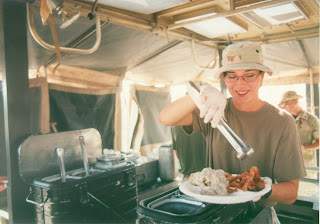Here are my thoughts, Stan:
As an Army cook in the 80's I used these units a lot. I forgot all about them till I saw the picture. One thing for sure ... you had to be careful or you could set the whole unit on fire and once in awhile the whole mess tent would catch fire.Safety was our biggest issue in Seabee field galleys. Many military cooks were burned over the 50 or 60 years these burners were used. I remember reading of a cook (in Bosnia, I believe) that stacked two lit M-2 burners on top of each other. The bottom unit heated the top unit to the point of explosion. Fire and the threat of burns was of little consequence when compared to the .223 M-16 ammunition that cooked off that morning in the mess tent.
Despite the long, exhausting hours in the field, the leaders always had to enforce safety awareness.
I couldn't begin to tell you how many gallons of GI coffee I made in those pots, or the gallons of green eggs I would deliver to the guys out at the remote sites on the frozen mornings. They didn't care what color the eggs were as long as the coffee was hot and you had enough food. We would stick slices of bread in the bottom of the mermite cans that carried the bacon to absorb all the grease.My basic formula for field coffee is this: Bring 12 gallons water to a boil in the 15-gallon stockpot. Remove water from heat and sprinkle the contents of a 2-1/2-pound can of coffee grounds over hot water. Let steep until strong enough for crusty, old Seabees. Sprinkle cold water from a #56 dipper over grounds and carefully ladle into a vacuum beverage jug. Make sure you save enough so the equipment operators can have there afternoon coffee in 120-degree heat at 29 Palms.
 Yes, I remember scraping greasy bread from the bottom of vat cans (Seabee and Marine term for mermites). Toward the end of a two-week exercise at 29 Palms in 1986, I saw a Marine field mess being set up on the perimeter of Camp Wilson. As a boot chief petty officer, I thought I'd walk over and meet the gunnery sergeant in charge of the galley.
Yes, I remember scraping greasy bread from the bottom of vat cans (Seabee and Marine term for mermites). Toward the end of a two-week exercise at 29 Palms in 1986, I saw a Marine field mess being set up on the perimeter of Camp Wilson. As a boot chief petty officer, I thought I'd walk over and meet the gunnery sergeant in charge of the galley. As I walked up to the gunny, I saw a maintenance tent with four rows of vat cans -- there must've been over 100 of the rectangular OD green cans in the tent. After quizzing the gunny, I learned the field galley was only feeding 200 Marines and Sailors in camp, all members of regimental headquarters.
The gunny was feeding remainder of Camp Pendleton-based infantry regiment out of the vat cans. Chow was being trucked in the back to 2-1/2-ton trucks to battalion and company positions throughout 29 Palms. The thing you have to understand about Marine cooks is they toss the inserts aside when pouring the meal into the cans.
But I will say this, at the four-hour mark, Navy corpsmen insist that the cook close the lid and return to the galley. They're not going to risk a case of the runs over old food.
US Marine Corps photo by Cpl. Eric McLeroy. It was taken at Camp Doha, Kuwait, circa 1998.


Steve, Speaking of danger... remember the immersion heaters to clean the mess kits and pots and pans? They would drip gasoline from a tank into a burn chamber and if they didn't light right away or the flame went out and a new guy tried to light it, it would blow the chimney sections about 30 feet in the air. and the poor kid (on KP) would wet his pants and scorch his eye brows. We would have at least 2 lines of 5 - 33 gal. barrels going most of the day keeping up with the pots and pans. Man was that water hot!!! But, sanitation was utmost important.
ReplyDelete